Abstract: This paper elaborates the principle and difference of 6-pulse and 12-pulse rectifiers from four aspects: theoretical derivation, measured data analysis, harmonic analysis, improvement countermeasures and performance comparison. There is an in-depth and comprehensive analysis of the rectification technology of high power UPS.
First, theoretical derivation
1、6 Pulse rectifier principle:
The 6-pulse refers to a full-bridge rectification consisting of 6 silicon controlled rectifier (thyristors). Since 6 switching pulses are separately controlled for 6 thyristors, it is called 6-pulse rectification.
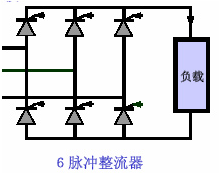
When ignoring the commutation process and current pulsation of the three-phase bridge thyristor rectifier circuit, assuming that the AC side reactance is zero, the DC inductance is infinite, and the delay firing angle a is zero, the AC side current Fourier series is expanded to:
 (1-1)
(1-1)
From the formula (1-1), the following conclusions can be drawn:
The current contains 6K?1 (k is a positive integer) subharmonic, that is, 5, 7, 11, 13... and other harmonics, the effective value of each harmonic is inversely proportional to the harmonic order, and The ratio of the effective value of the wave is the reciprocal of the harmonic order.
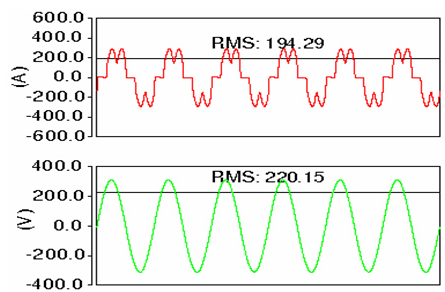
Figure 1.1 Input voltage and current waveform of 6-pulse A phase of computer simulation
2、12-pulse rectifier principle:
12 pulses means that on the basis of the original 6-pulse rectification, a set of 6-pulse rectifiers is added at the input end and after adding the phase-shifting transformer, so that the DC bus current is completed by 12 thyristors, so it is also called 12-pulse rectification.
The two three-phase rectifier circuits I and II shown in the figure below are 12-phase rectifier circuits through different joints of the transformer.
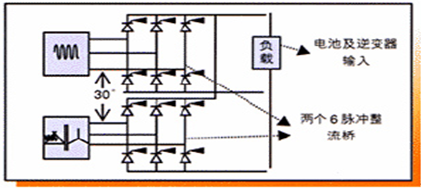
12-pulse rectifier schematic (composed of 2 6-pulse parallel)
The grid side current Fourier series of bridge 1 is expanded to:
 (1-2)
(1-2)
The voltage of the side line of the bridge II network is 30 times higher than that of the bridge I. Because the current of the side line of the network is 30 times higher than that of the bridge I?
 (1-3)
(1-3)
Synthetic network side line current
 (1-4)
(1-4)
It can be seen that the 5th, 7th, 17th, 19th, and...th harmonics generated by the two rectifier bridges cancel each other out, and only 12k?1 (k is a positive integer) subharmonic, that is, 11, 13, 23, 25 are injected into the grid. Each harmonic is equal, and its effective value is inversely proportional to the harmonic order, and the ratio to the fundamental effective value is the reciprocal of the harmonic order.
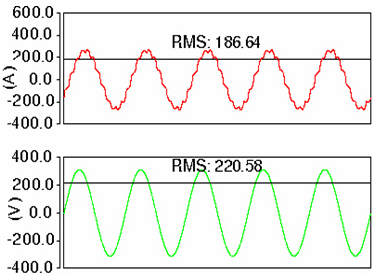
Figure 1.2 Input voltage and current waveform of A-phase 12-pulse UPS computer simulation
Second, the measured data analysis.
The above calculation is an ideal state, ignoring many factors, such as commutation process, DC side current ripple, trigger delay angle, AC side reactance, and the like. Therefore, there is a certain difference between the measured value and the calculated value.。
Theoretical calculation of harmonic tables:

A model of high power UPS harmonic measured data sheet:

From the comparison of the above two tables, the harmonic content of the 6-pulse rectifier is 5th harmonic, and the intensity of the 12-pulse rectifier is 11th harmonic, which is consistent with the theoretical calculation. The measured value of the 6th and 5th harmonics is larger than the calculated value, and the measured value of the 11th and 11th harmonics is the same as the calculated value.
Third, harmonic analysis and improvement measures
Harmonics may cause distribution cables, transformers to heat up, reduce call quality, air switch malfunction, generator surge and other adverse consequences; harmonics are divided into + order according to current phase sequence (3k+1 times, k is 0 and positive integer) ), - order (3k + 2 times, k is 0 and positive integer), 0 order (3k times, k is a positive integer).
+ the sequence current makes the loss worse, the - sequence current causes the motor to reverse and heat, and the zero sequence current causes neutral current to increase abnormally.
It can be seen from the measured values that the 6th harmonic of the 6-pulse rectifier is the largest, and 5 filters can be added to suppress the harmonics; the 11th harmonic of the 12-pulse rectifier is the largest, and 11 filters can be added to suppress the harmonics. The filter schematic is as follows:
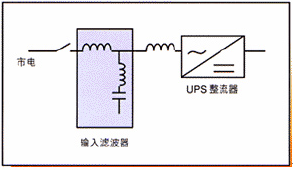
Figure: Common LC filter schematic
The harmonic comparison table of a model of high power UPS with filter installed is as follows:
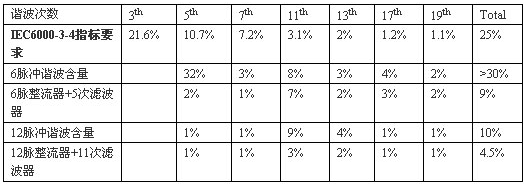
As can be seen from above table, the addition of the filter is very obvious for harmonic suppression.
It should be specially pointed out that the configuration of 6-pulse + 5th harmonic filter can achieve harmonic requirements of about 9%, but the capacitance of the 5th harmonic (250Hz) filter is larger, and the load on the UPS is lighter. (<15% rated load), the rectifier input current will lead input voltage. If the excitation winding of the generator is self-excited, it is easy to produce the positive feedback effect of the armature, and the output voltage of the generator will rise abnormally, causing the generator to enter. Shut down with protection status. Therefore, the 6-pulse + 5th harmonic filter scheme is not recommended for use when the UPS load is light. When the actual load is light, the 5th harmonic filter can be removed from the rectifier.
The single 12-pulse rectifier can also achieve a current harmonic index of about 10%, but there is no LC circuit with a large capacitance, which avoids the positive feedback effect of the excitation with the generator.
With 12-pulse rectifier + 11th harmonics, current harmonics of less than 4.5% can be achieved. The single harmonic and total harmonic content meet the requirements of IEC61000-3-4.
Table 1: Input current harmonic total content data under different load conditions

Table 2: A model 400KVA 12 pulse + 11 filters UPS input current total harmonic content table

What affects the grid is the absolute value of the harmonic current, not the percentage of the harmonic current. It can be seen from the above table that the absolute value of the harmonic current is the largest under full load conditions; in the case of half load and light load, the absolute value of harmonic current does not exceed the absolute value of 100% of the full load harmonic current. The 12-pulse + 11th-order harmonic filter has the smallest total input current total harmonics, while avoiding the shortcomings of "false compensation" of active filters and low system efficiency, due to the 12-pulse + 11th-order harmonic filter. The grid has the lowest pollution and is suitable for use in applications where reliability is high.
Fourth, performance comparison:
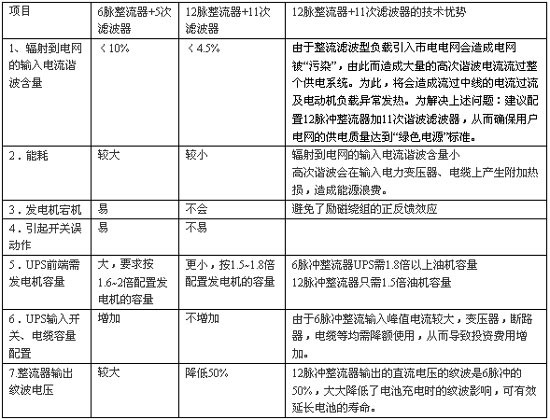
As can be seen from the above table, the 12-pulse rectifier is superior to the 6-pulse rectifier in many performance indicators. The 12-pulse rectification technology has been born since the 1970s. After continuous improvement and improvement, it has gradually become the preferred technology for high-power UPS rectifiers. The world's mainstream high-power UPS manufacturers have introduced 12-pulse UPS products.
In the end, in the case of sufficient investment, try to use the 12-pulse rectifier plus 11 filter UPS configuration. This configuration meets the requirements of the Information Industry Department's UPS industry standard input current harmonic component class I requirements (YD/T1095-2000) and the International Electrotechnical Commission IEC61000-3-4.
















